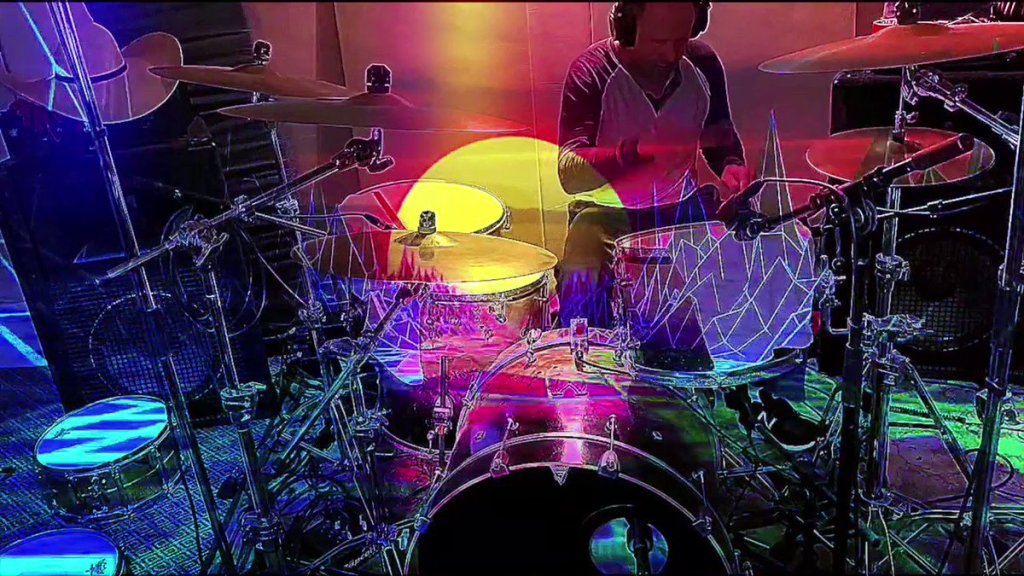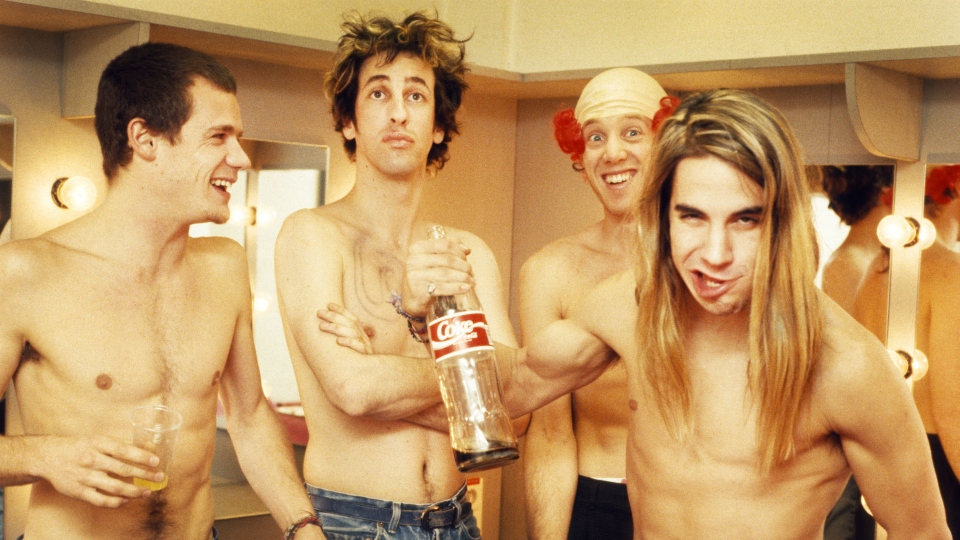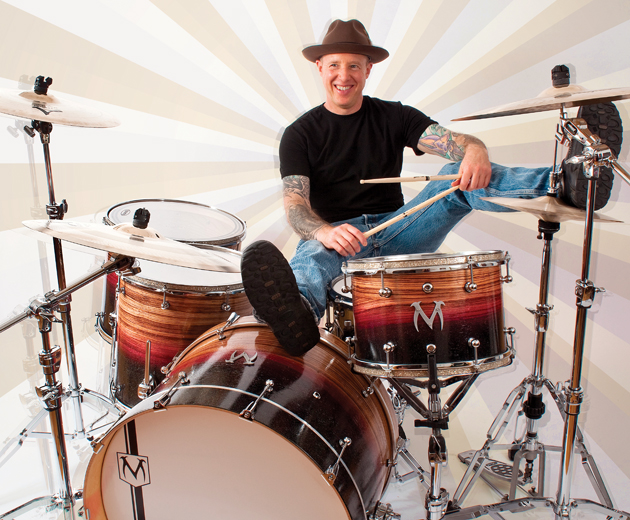
All images courtesy of Getty Images/Wiki Commons
Jack Irons’ thunderous journey has sent shockwaves through alternative music history in ways few others have before him.

By Andrew Daly
[email protected]
Whether backing up a young Hillel Slovak with the Red Hot Chili Peppers, working with Joe Strummer, or laying down energetic beats with Pearl Jam and Neil Young in the ’90s, Irons stickwork can be felt across an enduring generation of music.
And while his most infamous work came through those transcendent artists, it could be said that Irons’ most interesting musical endeavors have come via his experimental solo work.
“My first inclinations to record were back in 1994, just before joining Pearl Jam,” recalled Irons. “My very first recording was in a garage studio that Flea had at the time on a 4-track cassette. I then got into the 4-track cassette recording process and wanted to experiment with sounds. About a year after not playing with Pearl Jam in 1999, I felt a strong need to create again. Better home studios were becoming possible technology-wise fairly easily, so I dived in and got bitten by the mad scientist bug.”
Though his solo work was initially incidental, with three records released between 2004 and 2011, it seems that in 2022, Irons has found himself busier than ever. Intensely creative and ever-inventive, Irons released Koi Fish in Space through Org Music in early 2022. And as the year steams to a close, the veteran drummer is preparing to release yet another EP of experimental sounds in Dreamers Ball.
“I would say Dreamers Ball is a new period of music, where Koi had some roots in drum tracks and music I had been working on for the last few years,” Irons said. “Dreamers Ball was like Koi process-wise in the way I was creating the sounds. But most of it took place and was completed during 2021-2022 instead of tracks coming together over several years. When I first started doing my own music, I would come up with drum parts and create arrangements with just drums, but I haven’t approached a tune that way for a while now.”
Settling into the next phase of his career, Jack Irons took a moment with me to reflect on his upcoming Dreamers Ball EP, his early years with the Red Hot Chili Peppers, working with Pearl Jam, and beyond.
What message are you hoping to convey with your new music?
I experiment and come up with things that inspire me to finish. As something develops, there can be some emotional content that takes me down a path. What’s going on in life, in general, would influence things but not in a songwriter-specific way. The way I do it is I start recording based on a good feeling about a specific performance in the moment. It could be just drums that I’m playing to a song or something I feel inspired by. As drum tracks develop, I start to develop the tunes.
What are the origins of “Race Against Everything?”
“Race Against Everything” started with a drum track I found on my recorder, but I am not sure what it was. I decided to record another full drum set to it, and it had a natural flow that felt good for over 9 minutes. I wanted to create something with those drums and keep it long but not add too many different elements. The feeling of it to me is the constant push to get things done and so much to deal with these days, which is a feeling I tend to have often.
Can you recount the inception of “Seeing The Light From Underwater?”
“Seeing The Light From Underwater” was an existing drum track for a master for another artist I had recently recorded. I played with it effect-wise and turned it into something I wanted to finish a piece of music with. The synth melodies came, and one particularly reminded me of looking above from underwater.

My personal favorite is “A Wave Unknowingly Rises?” Can you break it down?
“A Wave Unknowingly Rises” was the last addition and, again, a drum track I had recorded playing along to an inspiring tune. I did some effecting, and I think the sounds and key parts that worked took on a mysterious quality.
What went into the ordering of the songs?
I like the shorter EP concept for my music in general, so it’s a bit easier to decide on an order that way. The titles would have something to do with feelings or things on my mind, but I wouldn’t say the title’s meanings went into the process of making the music. It’s more that the music reminds me of the titles.
What first sparked your interest in the drums?
I remember moving from one part of Los Angeles to another, and I saw a drum set in a music store window. It was a red sparkle kit, and I was attracted. I didn’t end up starting to play for a year or two later, but my first kit was a rental red sparkle. I think the brand was called Revelle or something like that. My first purchased kit was a Trixon.
How did your first group What Is This form?
What Is This was born out of friendship and a desire to play music with Hillel Slovak and Alain Johannes in junior high. Hillel invited me to his 13th birthday party, which was the beginning of our friendship. Some months later started to play with Alain Johannes. We first called ourselves Anthym, and then in high school, we started playing with Flea, and that group became What Is This. Flea left in 1982, but What Is This continued through the mid-80s with Chris Hutchinson on bass.
How did What Is This eventually morph into the Red Hot Chili Peppers?
I wouldn’t say it morphed, but Flea, Hillel, and I had years playing together in Anthym and What Is This, so that musical chemistry was an important part of RHCP’s beginnings. I would say that RHCP started in the post-high school years out of the experiences and friendships of Flea, Anthony, and Hillel.

You co-wrote many tracks on the Red Hot Chili Peppers’ first two records but did not perform. Why?
The original 1983 lineup that Hillel and I were part of wrote some of the earlier tunes that RHCP recorded for their first album, with Jack Sherman and Cliff Martinez replacing Hillel and me. We did perform those songs live in clubs in 1983, and the original demo versions came out on compilation records like Out In L.A. In 1986 the opportunity to return and play drums for RHCP presented itself, and it was the right time for me to come back.
Describe the energy and studio presence of the Red Hot Chili Peppers in the band’s early days.
The camaraderie of being young in a band with friends I grew up with is a lot of what I remember. That was a special experience. It was all part of the times as well, coming from the ’70s and how rock music was made, being in a band, and playing in garages and bedrooms; that was all part of it. I would say RHCP was a high energy give it your all, no matter what type of band.
As someone who worked closely with Hillel Slovak, how do you remember the man and the musician?
He was a very close friend that I met when we were 13. It was our friendship that ultimately started our path in music. We made a lot of music together from ages 13-25, and he was a very important part of my life and a big musical influence.
How did you most affect Joe Strummer’s music upon joining his group?
Joe gave me a chance to audition at a very difficult and pivotal time. He got me back behind a drum kit, and somehow I got the gig. I couldn’t say how I affected his music, but I finished up a handful of recordings for Earthquake Weather, and he took me on the road later that year. A lot of important good things came on that tour, and it got me back on my feet.
What ultimately moved the needle toward you joining Pearl Jam?
I met Eddie Vedder on the Joe Strummer tour at a club in San Diego. We became very friendly, played lots of basketball, and had regular hangs. One day I met with Stone [Gossard] and Jeff [Ament] about starting a new band, and they gave me a tape of new material. I wasn’t ready to start a new life, but they also asked if I knew any singers. I had seen Eddie play with his band, and he could really sing great, so I passed that tape on to him. Time, life changes, and friendships ultimately led to being able to join Pearl Jam some years later.

Can you recall your first session and show with Pearl Jam?
The first official session was the Merkinball sessions, and those were part of the Mirrorball sessions, I do believe. The first show was a Bridge School Show, and I played a Djembe – not that well – with a shaker taped to my shoe. I was pretty nervous. I think Pearl Jam was ready for some experimenting at the time, so it felt right to have me come aboard.
Mirror Ball is one of my favorite records of all time. How did the project initially get off the ground?
Neil [Young] and Pearl Jam had done some playing together prior to my joining. That extended into Pearl Jam working with him again for a concert when I first joined, and from that show came the opportunity to record with him. The recordings were done spontaneously and quickly, with Neil letting us do our thing with the tunes he wrote for those sessions. It was a great experience as I had always been a big fan of his music.
How did your approach with RHCP and Pearl Jam differ, and how is that still reflected in your style today?
The music required a morphing process naturally. I was fortunate that my musical parameters worked for both bands and that their approaches as musicians worked with mine. I would say the last year of being in Pearl Jam and the recording of Yield is what extended to my playing in the following years. A kind of relaxation took place for me drum-wise at the time and has stayed with me.
How does working with other instruments aside from the drums allow you to stretch out?
I am mostly a drummer in terms of what I can do with other musicians, but I like to experiment with sounds and see what I can find musically with my drumming. I think the abstract nature of doing music this way offers me a strange, needed escape but also gives me energy for life’s usual things.
Do you have any regrets?
Not really. I wished I was in a place to enjoy more of the experiences in general, but that wasn’t my life’s journey at the time. But I don’t really know; I always like to create and play drums because the drums really help give me energy in general. I hope some cool musical opportunities continue to present themselves to me in the future.

– Andrew Daly (@vwmusicrocks) is the Editor-in-Chief for www.vwmusicrocks.com and may be reached at [email protected]

One thought on “Former Red Hot Chili Peppers & Pearl Jam Drummer Jack Irons Speaks on New Music, Neil Young & More”